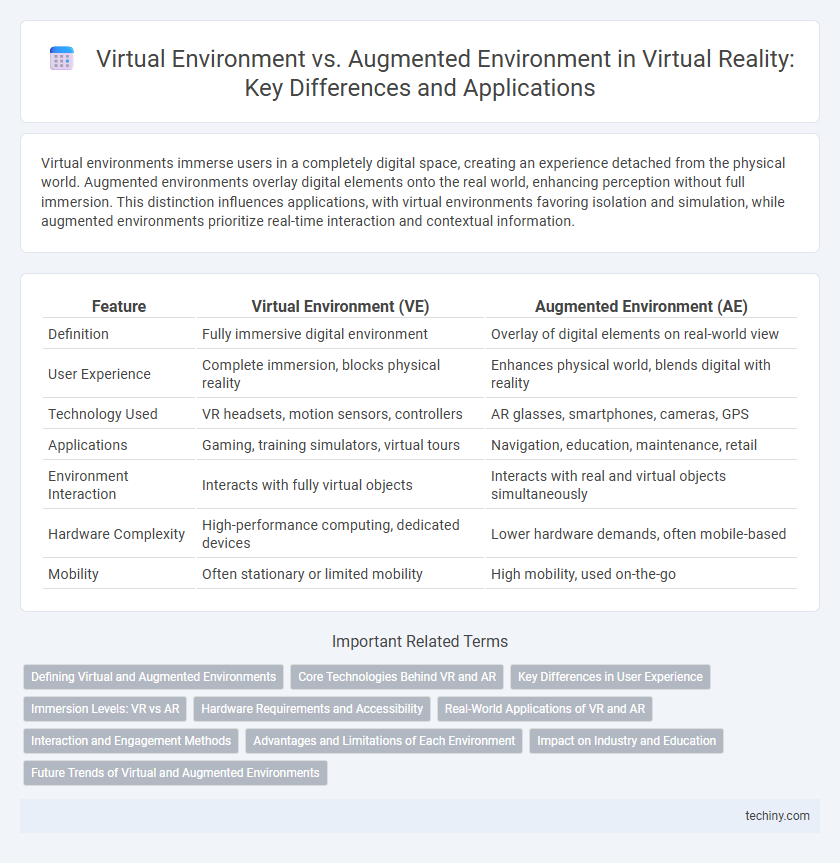Virtual environments immerse users in a completely digital space, creating an experience detached from the physical world. Augmented environments overlay digital elements onto the real world, enhancing perception without full immersion. This distinction influences applications, with virtual environments favoring isolation and simulation, while augmented environments prioritize real-time interaction and contextual information.
Table of Comparison
| Feature | Virtual Environment (VE) | Augmented Environment (AE) |
|---|---|---|
| Definition | Fully immersive digital environment | Overlay of digital elements on real-world view |
| User Experience | Complete immersion, blocks physical reality | Enhances physical world, blends digital with reality |
| Technology Used | VR headsets, motion sensors, controllers | AR glasses, smartphones, cameras, GPS |
| Applications | Gaming, training simulators, virtual tours | Navigation, education, maintenance, retail |
| Environment Interaction | Interacts with fully virtual objects | Interacts with real and virtual objects simultaneously |
| Hardware Complexity | High-performance computing, dedicated devices | Lower hardware demands, often mobile-based |
| Mobility | Often stationary or limited mobility | High mobility, used on-the-go |
Defining Virtual and Augmented Environments
Virtual environments immerse users in a fully digital space created by computer-generated simulations, allowing complete interaction with a synthetic world. Augmented environments overlay digital content onto the real world, enhancing physical surroundings through devices like smartphones or AR glasses. These definitions highlight the distinct levels of interaction and immersion that characterize virtual and augmented reality technologies.
Core Technologies Behind VR and AR
Virtual environments rely heavily on immersive technologies such as head-mounted displays (HMDs), motion tracking sensors, and spatial audio to create fully simulated worlds, primarily driven by real-time 3D rendering engines like Unity and Unreal Engine. Augmented environments integrate computer-generated content with the physical world using advanced technologies like SLAM (Simultaneous Localization and Mapping), ARKit, and ARCore, leveraging device cameras, GPS, and depth sensors to overlay digital objects seamlessly. Core technologies behind both VR and AR include high-precision sensors, advanced optics, and powerful processing units that ensure accurate environment mapping and user interaction.
Key Differences in User Experience
Virtual environments immerse users in a fully computer-generated space, enabling complete sensory engagement and interaction within a distinct digital world. Augmented environments overlay digital elements onto the physical world, enhancing real-world perception while maintaining situational awareness and context. User experience in virtual reality emphasizes total immersion and detachment from the real environment, whereas augmented reality prioritizes blending digital content with real-life surroundings for interactive and contextual engagement.
Immersion Levels: VR vs AR
Virtual Reality (VR) offers complete immersion by replacing the physical world with a fully digital environment, enabling users to interact within a 360-degree virtual space. Augmented Reality (AR) overlays digital elements onto the real world, enhancing the user's perception without fully detaching them from their surroundings. The immersion level in VR is significantly higher due to total sensory engagement, while AR maintains partial immersion, blending digital content with physical context.
Hardware Requirements and Accessibility
Virtual environments demand high-performance hardware such as VR headsets, powerful GPUs, and motion tracking sensors to create fully immersive experiences. Augmented environments rely on more accessible devices like smartphones, tablets, or AR glasses, requiring less processing power and enabling easier integration into everyday life. Accessibility in AR is enhanced by lower cost and compatibility with existing mobile technology, whereas VR's hardware intensity limits widespread adoption.
Real-World Applications of VR and AR
Virtual environments immerse users in fully digital worlds, primarily used in training simulations, gaming, and virtual tours where complete sensory engagement is essential. Augmented environments overlay digital information onto the real world, enhancing applications in fields like medical visualization, industrial maintenance, and retail by providing contextual data without disconnecting from the physical surroundings. Both technologies drive innovation in education, healthcare, and design, improving user interaction with complex information in practical, real-world scenarios.
Interaction and Engagement Methods
Virtual environments offer immersive interaction through fully simulated sensory experiences, enabling users to engage with digitally created worlds using motion controllers, hand tracking, and haptic feedback. Augmented environments integrate digital elements into the real world, enhancing engagement via gesture recognition, eye tracking, and contextual overlays that respond to physical surroundings. Interaction in virtual reality relies heavily on complete immersion for user presence, whereas augmented reality enhances real-world engagement by blending digital and physical inputs for seamless user experience.
Advantages and Limitations of Each Environment
Virtual environments offer immersive experiences by completely replacing the physical world with a digital one, enabling users to engage in simulations for training, gaming, or education with full sensory input. Their primary limitation is the disconnection from real-world cues, which can cause motion sickness or reduce situational awareness. Augmented environments overlay digital content onto the real world, enhancing perception and interaction without obstructing natural surroundings, making them ideal for navigation, maintenance, and collaborative tasks, but their effectiveness is limited by factors such as lighting conditions and device battery life.
Impact on Industry and Education
Virtual environments immerse users in fully simulated worlds, revolutionizing training and design processes in industries such as manufacturing, healthcare, and architecture by enabling risk-free prototyping and skill development. Augmented environments overlay digital information onto the real world, enhancing educational experiences through interactive simulations and real-time data visualization, improving learner engagement and retention. Both technologies drive efficiency and innovation, with virtual reality providing immersive skill mastery and augmented reality facilitating contextual learning and operational support across various sectors.
Future Trends of Virtual and Augmented Environments
Virtual environments are rapidly advancing with fully immersive experiences powered by AI-driven graphics and haptic feedback, while augmented environments integrate real-world data with digital overlays through 5G and edge computing for real-time interaction. The future trends emphasize seamless blending of virtual and augmented elements to enhance remote collaboration, education, and entertainment with increased spatial awareness and context-sensitive adaptations. Enhanced AI capabilities and sensor innovations are expected to drive more personalized, adaptive, and interconnected virtual-augmented ecosystems.
Virtual environment vs Augmented environment Infographic

 techiny.com
techiny.com